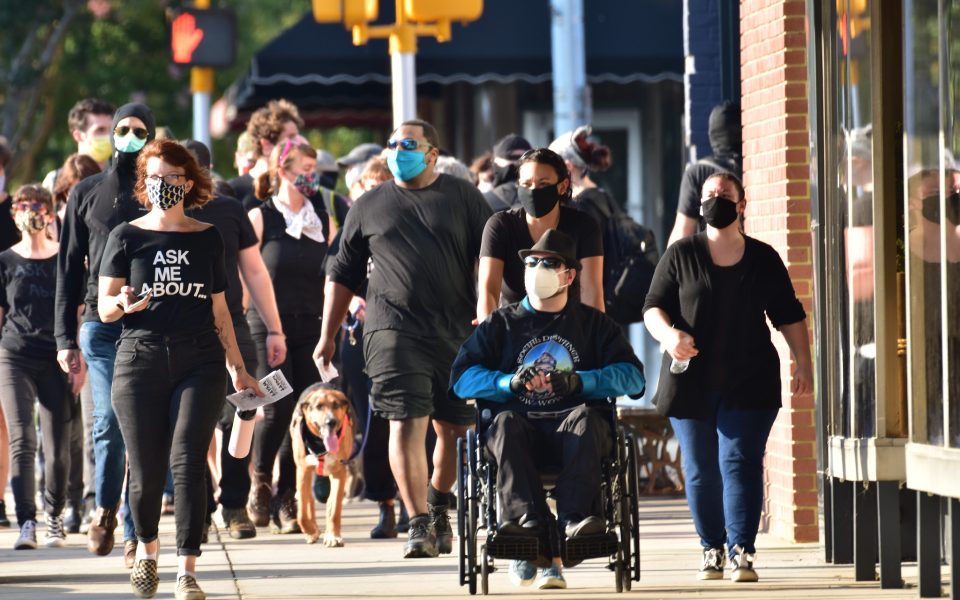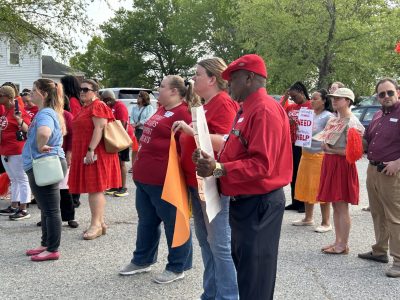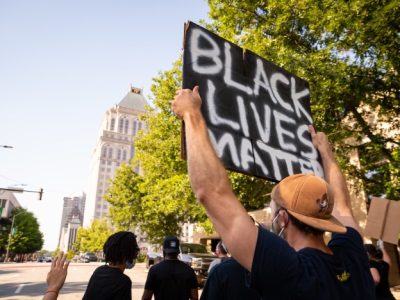Photo by Anthony Crider
Close to 200 people dressed in black walked around downtown Graham on Thursday evening without signs, chants or other vocal expressions, with the exception of one or two stray placards and a lone voice occasionally calling to passing motorists: “Black lives matter!”
But the message was likely lost on no one in this neo-Confederate holdout in the heart of North Carolina’s Piedmont region: solidarity with Black victims of police brutality and repudiation of the north-facing Confederate monument, ratifying the city’s troubled history with white supremacy as it soars 30 feet into the air on the north side of the Historic Courthouse.
Billed as a “Peaceful Living Library,” the event saw participants distribute a handmade comic book telling the story of Wyatt Outlaw, a Black town commissioner and constable in Graham who led a group of men who shot at but did not injure Ku Klux Klan members riding through town to frighten Black residents during the Reconstruction period. In retaliation, on Feb. 26, 1870, a Klan-led mob of 63 men dragged Outlaw from his home and hung him from a tree in Court Square. They pinned a note on his chest reading, “Beware ye guilty, both black and white.” Outlaw’s murder went unpunished, and when a grand jury issued indictments, the state General Assembly repealed the law that formed the legal basis for the indictments. The Confederate monument was erected at the courthouse by the United Daughters of the Confederacy 44 years later.
The streams of black-clad participants moving down the broad sidewalks flanking Court Square and scrupulously following pedestrian regulations on Thursday made a distinctive impression, with messages inscribed on masks and T-shirts standing in for placards: “I can’t breathe,” “Black lives matter,” “Losers don’t get trophies” and “Fuck Trump.” They occasionally received a honk of support or an extended middle finger in angry defiance, but overall the reaction from motorists in the busy traffic circle was muted, at least for the first 90 minutes. As a small crew pulled out a cooler and handed out bottled water and snacks, the event felt relaxed, with a racially diverse group of people chatting as they walked, laughing and enjoying a cooling breeze.
Over the past five years, Graham has become a focal point for tension over monuments to the Confederacy. In the aftermath of white supremacist Dylann Roof’s June 17, 2015 murder of nine parishioners at Emanuel AME Church in Charleston, SC, when the call for removing symbols of the Confederacy went up across the nation, locals organized a demonstration in support of the monument in Graham that drew 1,500 people. During a May 2017 Confederate Memorial Day celebration in Graham, two Marines were arrested for climbing atop a building and hanging a banner featuring the identitarian symbol used by European white supremacists and the initials “YWNRU,” short for “You Will Not Replace Us.”
Members of Alamance County Taking Back Alamance County — named as a hate group for a time by the Southern Poverty Law Center and better known by its acronym ACTBAC — frequently appeared at UNC Chapel Hill after antiracists toppled the “Silent Sam” Confederate monument in August 2018. ACTBAC founder Gary Williamson plunged a knife into the tire of a piece of heavy equipment used to remove the plinth and associate Barry Brown was convicted of assault for punching a student in the face. Meanwhile, law enforcement and local white conservative residents in Graham have become convinced in the past two years that protests against Alamance County Sheriff Terry Johnson’s cooperation with ICE is a cover for a conspiracy to tear down the Confederate monument, giving rise to volatile scenes and recruiting visits by white supremacists.
Alamance County, with Graham as its seat of government, has remained a bastion of Confederate support, as protesters toppled monuments in Durham and Chapel Hill, in 2017 and 2018 respectively, and as local governments removed them in Winston-Salem and Chatham County in 2019. The rebellion against police brutality and systemic racism that erupted after the police killing of George Floyd in Minneapolis last month opened a gusher of renewed action against Confederate monuments in North Carolina and elsewhere: Protesters tore down two monuments at the Old State Capitol in Raleigh on June 19, and a state crew completed the removal of another monument in Raleigh at the order of Gov. Roy Cooper on Tuesday.
On Monday, Granville County commissioners signed an order removing the monument in Oxford, 30 miles northeast of Durham, citing a “credible threat.” And after a Wilmington police officer was caught on tape fantasizing about massacring Black people, the city quietly removed two monuments on Thursday.
Alamance County Manager Bryan Hagood recommended removing the monument in Graham and storing it in a safe location in a June 20 email to county commissioners, writing, “I believe it will come a point where the deputies will have to choose to use potentially deadly force in the course of” protecting the monument. “I believe this would be a terrible thing for Alamance County, to have someone seriously injured or killed by one of our deputies or a Graham police officer in an altercation that began as protecting the memorial.” Hagood added, “I am also concerned that we are, at this moment, seeing Main Street Graham fill up with citizens who support the memorial’s location and may be willing to resort to violence on their own to maintain it.” In response, county commissioners have signaled they have no appetite for removing the monument.
On the same day Hagood shared his recommendation with the commissioners, Megan Squire, a computer science professor at Elon University who is a nationally renowned expert on right-wing extremism, was assaulted by a man as monument supporters gathered on Court Square. Another man lunged at Anthony Crider, an astrophysics professor at Elon University who is married to Squire, and was charged with disorderly conduct.
On Thursday, participants in the Black Lives Matter walk heeded a request in an email circulated in advance by organizers to refrain from engaging with ACTBAC and from crossing the street to the courthouse.
Graham Mayor Jerry Peterman monitored the event from a sidewalk.
“They’re just as peaceful as can be,” he said, adding that he walked with them on June 20.
The flier for the event conspicuously avoided any wording that could be construed as a protest or a demonstration in a clear effort to remain in compliance with the city of Graham’s restrictive public assembly ordinance. The five-page ordinance prohibits any “assembly together or concert of action between two or more persons for the purpose of protesting any matter” without a permit, with an exception for “the peaceful assembly of any group for orderly expression or communication between those assembled.”
The ordinance also requires that permits for protests be secured 24 hours in advance, and allows permits to be issued only on condition that the event “not require excessive diversion of police from other necessary duties” and “can be conducted without unreasonable interference with normal vehicular or pedestrian traffic.”
At 7:30 p.m. on Thursday, a Graham police officer told Mayor Peterman he was being summoned to the command center. Five minutes later, an Alamance County Sheriff’s cruiser circled the courthouse announcing, “A state of emergency has been imposed, and we have a 9 p.m. curfew.” The curfew, which was issued by the city of Graham, was soon amended to 8 p.m., and Peterman notified the walkers in person.
As the curfew approached, monument supporters began to show up. A Graham police officer approached a man waving a dual Confederate and American flag, and persuaded him to put it away. Large pickup trucks displaying the Confederate flag rounded the traffic circle.

In an open letter to county commissioners, law enforcement and residents on Sunday, ACTBAC founder Gary Williamson characterized Alamance County as “one of the last true conservative run counties” besieged by sinister outside forces. He blamed the conflict in Alamance County on “Antifa,” echoing the baseless claims by President Trump and Attorney General William Barr that “antifa” — a tactic for responding to fascism and white supremacy — was responsible for instigating and carrying out acts of violence during the ongoing protests against police brutality.
Williamson’s characterization of antiracists from Alamance County along with neighboring Orange and Durham counties who engage in activism on their own dime reveals a paranoid, conspiratorial frame of mind.
“Antifa is nothing more than a few far-left extremists that do reside in our county, but the majority are outside agitators,” he wrote. “These agitators go from state to state, county to county to further their agenda. Antifa is not just a group of people. It is an extremely well-rounded strategic plan. They are highly funded and organized.”
About 10 minutes before the curfew, self-proclaimed monument “protectors” gathered in the northeast parking lot across from the monument, ignoring a police officer’s request to stay on the sidewalk. One of the “protectors” was tagged on the Sanctuary Second Amendment Alamance Facebook page by a user who wrote: “Looks like a bunch of pussies if you ask me. Looks like walking target practice.”
One man who had been hanging out ouside a bar earlier muttered, “You’re liable to get shot doing this in Graham.” He ignored a request for elaboration, and his friend warned the reporter: “Stay in your lane.”
As the antiracists headed for their cars in compliance with the 8 p.m. curfew, a group of young men parked a pickup truck on Main Street that displayed Confederate and Blue Lives Matter flags in the bed.
“They ain’t getting our statue,” one of them yelled. “Hell no.”
Three men strolled through the municipal parking lot taking photos of license plates on their cell phones.
They stayed about 10 minutes after the curfew and then circled the courthouse once before leaving. One user on the Sanctuary Second Amendment Alamance page commented, “I’m going to follow them when they leave… and find out where they live. Country boys are going to hunt tonight.”
Join the First Amendment Society, a membership that goes directly to funding TCB‘s newsroom.
We believe that reporting can save the world.
The TCB First Amendment Society recognizes the vital role of a free, unfettered press with a bundling of local experiences designed to build community, and unique engagements with our newsroom that will help you understand, and shape, local journalism’s critical role in uplifting the people in our cities.
All revenue goes directly into the newsroom as reporters’ salaries and freelance commissions.





Well past time to arm up and remove with force, those preventing protest and advancement in this country. Traitors, flying ‘loser’ flags, intimidating with the help of police? That invalidates any expectation of respect or compliance any legit police might expect.